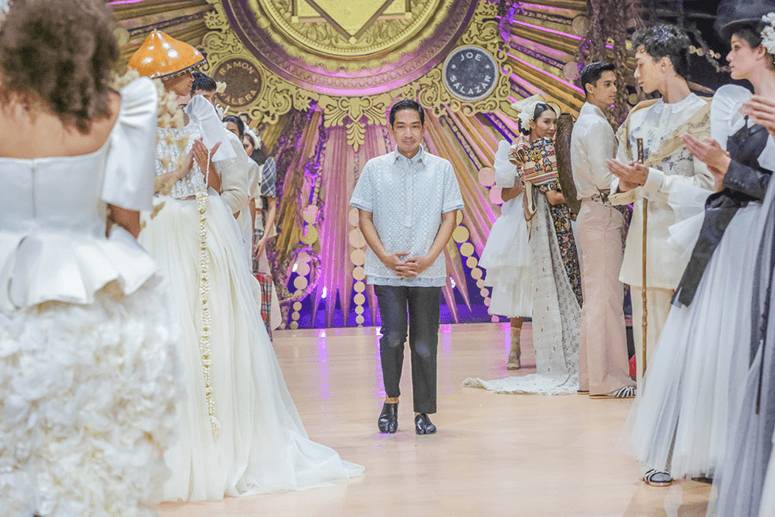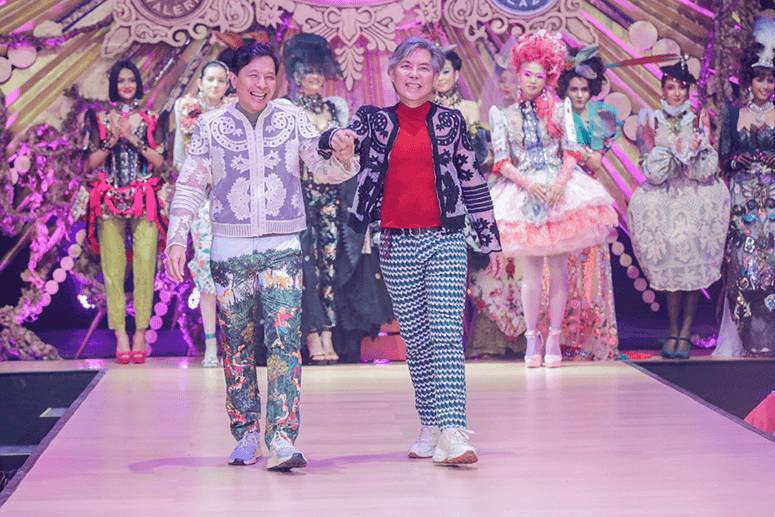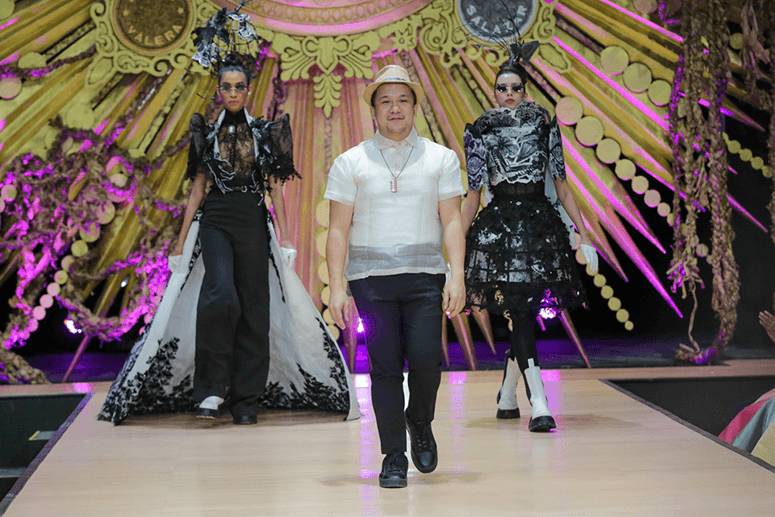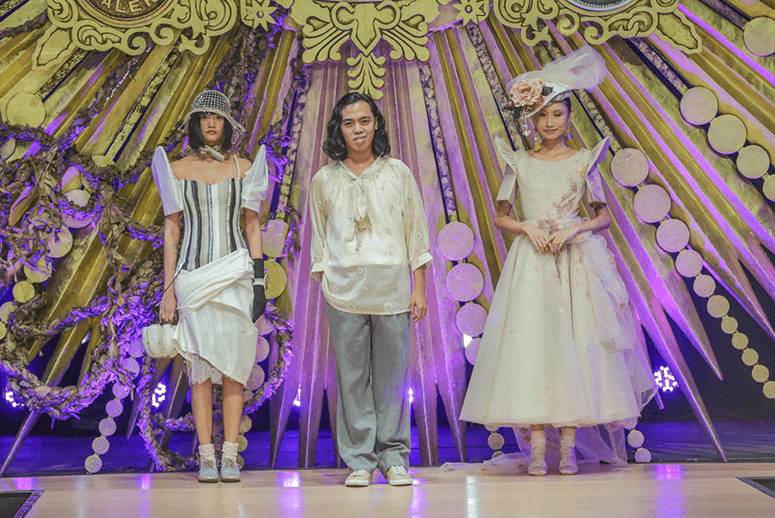A glorious finale for Ternocon 3
The final winners for Ternocon 3 were chosen last Saturday evening after the 12 finalists screened from all over the Philippines showed their creations of the balintawak, the country version of the terno, to a packed crowd at CCP’s Ignacio B. Jimenez Theater.
The gold medal was bestowed on Yssa Inumerable, who utilized inabel from Abra and burdang Taal from their family’s ancestral home in Batangas to create garments that melded 1800s sportswear and the Gibson girl with our native attire.

The 19th-century Tipos del Pais of Justiniano Asuncion had been a starting point to design her pieces translated to floral boleros worn over button-down shirts paired with a plaid tapis and skirt. Reflecting her affinity for draping and tailoring that merged masculine and feminine silhouettes, she envisioned her collection to “redefine the balintawak into something more revered, valued and respected, with the ideals of a 21st-century Filipina.”

The modern woman was definitely in the mind of silver medal winner Gabbie Sarenas, who shared that “even if it’s anchored towards tradition, there is a contemporary feel that you can use it in several ways.”
She mixed flat embroideries and 3D elements of stripes and florettes for her dainty but versatile pieces in piña and piña silk that “you can reverse, wear in a casual dinner or a wedding, reuse, add and subtract,” a boon for the busy, multitasking lifestyle of today while retaining poetic femininity.
She titled her collection “Sumpa Kita,” from the sampaguita: “So it’s a promise. It’s always been that soul of the sampaguita that I put in my heart.”

At the start of the competition, bronze medal recipient Glady Rose Pantua lamented how “we usually associate the balintawak with colonial Manila and the Visayas only but never our city of Zamboanga in Mindanao.”
So she harnessed the Yakan weave in her balintawak, making it more opulent with embroidery and beading that were skills inherited from her lola. On her plaid tapis and alampay are intricate embroideries of flora and cultural icons like the Rizal Monument and the terno—testaments to a love of her native city and country.

Also onstage were our collection, those of our fellow mentors, Dennis Lustico and Joey Samson, as well as that of Hannah Adrias, gold medal winner of Ternocon 2. The program, conceptualized by Ternocon artistic director Gino Gonzales, together with director Dexter Santos, provided a theatrical experience that incorporated Philippine culture and music—from period kundimans rendered exquisitely by the Philippine Madrigal Singers to OPM hits by the likes of Celeste Legaspi and Eva Eugenio playing from a jukebox.

The biennial convention and competition has become one of the most anticipated fashion and cultural events, with many on the waitlist and guests planning way in advance for their outfit, and this edition, the first after the pandemic, generated even more buzz, as was seen at the pre-show merienda cena with the country’s best-dressed coming in their designer’s takes on the balintawak—a veritable fashion extravaganza to match the one they were about to see onstage.
The mentees displayed an amazing range of backgrounds, skills and sensibilities, not to mention ideas, that made us realize the rich fabric of our country and its people.
True enough, the show was a visual feast and a triumphant finale for everyone, fulfilling the hopes of what the organizers have been trying to achieve from way back.

Ben Chan of Suyen Corporation’s Bench has always inspired our love of All Things Local, the title of one of the first books that he published together with Pinoy Pop Culture by Gilda Cordero-Fernando (2001) and Fashionable Filipinas by Gino Gonzales and Mark Higgins. The last one, published in 2015, was launched at a cocktail that would plant the seed for Ben’s dream of restoring the popularity and pride in wearing the terno.

Together with Gino, a scenographer and educator, they realized the importance of education—going back to the history of how our national dress evolved, hand in hand with our rise as an independent nation, together with the proper way of constructing and wearing it. It was only natural for the Cultural Center of The Philippines, represented by Margie Moran-Floirendo, to get on board to create the first Ternocon in 2018, followed by the second in 2022.

The finalists chosen from over a hundred applicants screened early last year, started their Ternocon experience with a series of lectures on the historical, cultural, and social aspects of the terno and balintawak, as well as locked-in workshops and mentoring sessions headed by Gino, Inno Sotto as head mentor, Chinggay Bernardo and Eric Cruz of CCP, together with the designated mentors.
The mentees displayed an amazing range of backgrounds, skills, and sensibilities, not to mention ideas, that made us realize the rich fabric of our country and its people. This group of Gen-Z creatives gave us a glimpse of the future of our national dress, if not the future of our fashion industry and its role in nation building.

The country’s natural resources and culture provided a wealth of inspiration. The sunset of Al Rey Rosano’s municipality of Santa Catalina, Negros Oriental, was translated using chiffon and organza that he painstakingly ruched and micro-pleated to create subtle gradients of colors.
Cheetah Rivera of Quezon City took the wings of the rustic and common line butterflies of Tawi-Tawi and Palawan to make her pieces take flight with micro-pleated ruffles tracing a woman’s curves. They achieved her desire that “bawat piraso ng terno ay magmukhang isang awitin.”
Amor Albano of Ilocos Norte was captivated by the lightness of the layers of pabalat pastillas wrappers and paintings of our masters seen at Ternocon’s excursions to the National Museum to create a balintawak that exuded ease through flowy tiers of organza in different shades that mimicked the layers of brushstrokes of Philippine obra maestras.

Stimulation also came from unpredictable, and even dark, sources. Bree Esplanada looks to Cebu’s nocturnal side: “Gusto ko makuha yung mga taboo things—folklore, horror—parang magce-create ng paranoia. There’s beauty in the dark and for me everything has inspiration, so mine is somewhere na hindi mo makikita.” An excellent illustrator, he conjured moths, eyes, birds, a tikbalang and other creatures to inhabit his pieces using a sublimation-printed fabric, “so para siyang nagse-set ng mood sa madilim na parang may nakatingin sa iyo.” The images are never scary, though, because of his light hand that imbues the figures with childlike innocence.

Glynn Alley Magtibay found a spark of possibility looking at X-rays in the hospital of her town in Oriental Mindoro: “Napakaganda kasi, unique siya, yung X-ray mo iba, X-ray ko iba.” With white backing, she was able to turn images of body parts into interesting patterns that make for unusual, contemporary versions of the national dress. The sustainable angle also appealed to her: “Gusto ko po na ma-encourage yung young generation na yung waste na akala mo patapon na, magagamit mo basta maganda ang idea.”

Karl Nadales also saw the value of recycling and making do with what you have as he ruminated on Bukay, the bag lady in Iloilo: “Every layer of her, pineel off ko para makita ko yung ganda.” The exercise was mirrored in his deconstruction of the balintawak to create a conceptual piece that also taught him many lessons: “Yung mga materials na ginamit, mga found objects, fabric scraps, just like si Bukay, kuntento na siya kung anong meron siya.”

For Dee Javier and Marc Carcillar, their approaches were rooted in experience. Dee drapes and pleats the story of his relationship “where you are enveloped with love and innocent intentions and in the end you are defeated and betrayed by fanciful words and broken promises.”

Crumpled love letters with words smeared by tears wrap the body while another piece traces the verses of Francisco Balagtas from “Florante at Laura.” Marc Carcillar experienced and empathized with the challenges of designing and crafting a garment and how each person in the process was important and interconnected. “Nakita ko ang hirap pala ng buhay ng mga creative people, especially those helping us, which is the sewer.”
He says his entry “inspired siya sa bigat ng fabric, which is from tapis, going to alampay, so connected sila in a way which reflects the imperfections and hardships of the creative industry.”

Geom Hernandez of Batangas and Bon Hansen Reyes of Rizal both root for inclusivity. Trying to achieve shapelessness to fit everyone, Geom uses drawstrings and other devices with garments that he dyes intricately with lovely patterns so that “whatever vibe, style or body shape you have, there will always be a terno and balintawak for you.”

Bon, on the other hand, said he “played with the tapis and alampay using menswear techniques—a big collar for the alampay and a button-down shirt for the tapis—to create pieces that were genderless and everybody can wear.”
Ultimately, the Ternocon experience was a success because of how it has moved the design and appreciation of our national dress forward—appreciating its history while making it relevant for the times. With how the terno is now being worn more often at events, we can look forward to seeing more of the balintawak as well, being worn with pride and fostering a love of our culture.



